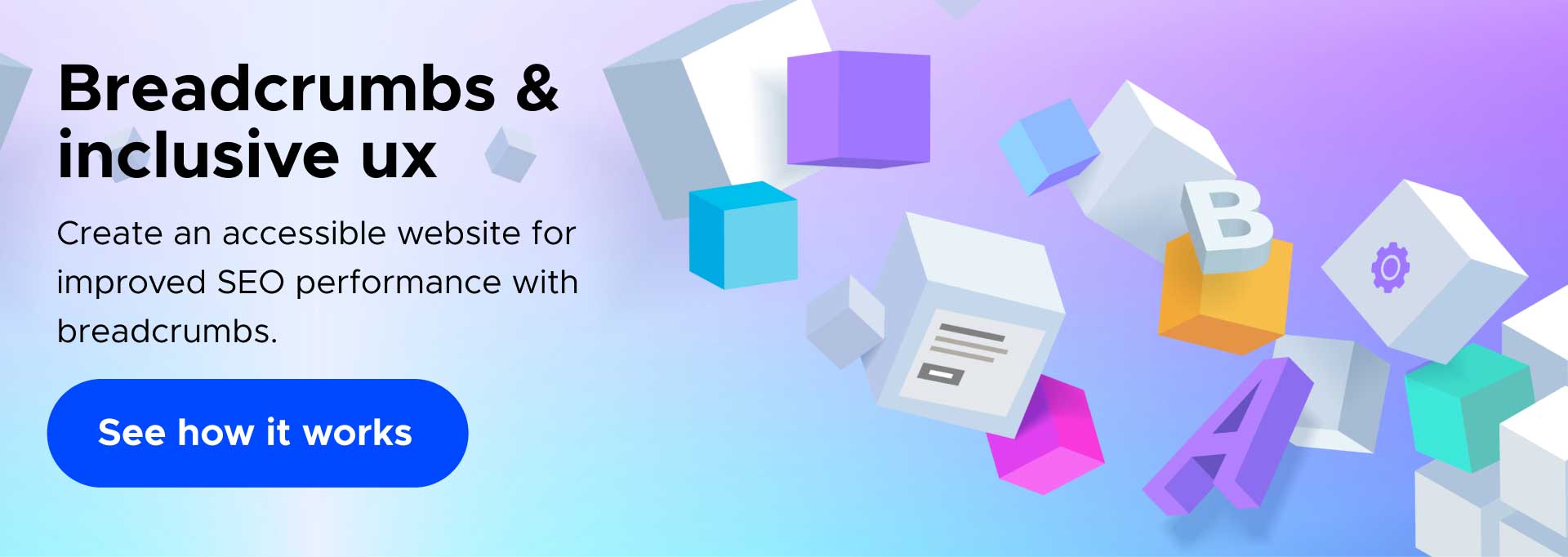Leave a trail of breadcrumbs: a UX navigation guide

Finding our way around a website shouldn’t require a compass. Or a map. Neither should the user experience be a series of complicated twists and turns. That’s where breadcrumb navigation plays a huge role.
In our guide, we’ll unpack the strategies needed to create web design that requires zero effort to navigate and is easy for everyone, regardless of their abilities, to explore. We’ll explain how to lay down a trail of breadcrumbs where every step your users take on your site is in the right direction!
What are breadcrumbs in web design?
Breadcrumbs in websites are a type of navigational aid. They’re commonly used in web design to help visitors locate their current position within a website. Website breadcrumbs are small pieces of text that appear at the top of a web page and typically link back to the home page.
Breadcrumbs in web design are usually a horizontal path of links, with the current page being the last link in the chain. This site navigation helps end users retrace their steps and reminds them where they are on your site.
So, why are they called breadcrumbs? Remember the story of Hansel and Gretel? Hansel dropped bread pieces on the ground so they could trace their steps home if they got lost in the woods. That’s what inspired the breadcrumbs on websites today.
So what exactly is breadcrumb navigation? And how does this all relate to helping people with disabilities?
What is breadcrumb navigation?
Breadcrumb navigation is a vital element in user experience (UX) design, guiding users through a website’s hierarchy without confusion.
When designing user interfaces (UI), many websites incorporate breadcrumbs to enhance user navigation and experience.
Here are three examples of breadcrumb navigation. These examples will illustrate how breadcrumbs are used in the UI design of different types of websites:
1. eCommerce websites
Example: A customer browsing an online clothing store.
Breadcrumb navigation: Home > Women’s Clothing > Dresses > Summer Dresses
Description: This breadcrumb helps users track their shopping journey from the homepage, through the broad category of women’s clothing, down to a specific type of dress, making it easy to navigate back to a previous section or the home page.
2. Educational institution websites
Example: A student accessing course material on a university website.
Breadcrumb navigation: Home > Undergraduate Programs > Department of Biology > Courses > Genetics 101
Description: This breadcrumb trail assists students in navigating from the university’s homepage to a specific course within a department, allowing for easy backtracking to broader categories or direct access to related courses.
3. Healthcare information portals
Example: A user seeking health advice on a medical information website.
Breadcrumb navigation: Home > Health Topics > Mental Health > Anxiety Disorders > Treatment Options
Description: The breadcrumbs help users move from general health topics to more specific information about a particular condition, providing a clear path back to broader categories or the home page for further exploration.
Now, let’s look at another way breadcrumbs can improve your website performance.
Breadcrumbs in SEO: why they matter for your website
SEO and breadcrumbs navigation are a very special relationship; breadcrumbs tell people where they are on your website and they help Google and other search engines understand your site structure. They can also boost SEO performance by enabling search engines to index a website quickly, resulting in higher rankings on a Search Engine Results Page (SERP).
Optimizing SEO drives greater visibility, which can help attract more visitors and boost your online sales efforts. In addition, a great UX experience can also increase repeat visitors to your site, encourage word-of-mouth consumer endorsement, and elevate your company image.
Breadcrumbs can also be a game changer for your site’s accessibility, making it easier for people with disabilities to fully navigate your website. The integration of breadcrumb links strengthens this inclusive approach, offering a clear and simple navigational path to benefit all users.
Let’s break down some more of the benefits of breadcrumbs.
The benefits of breadcrumb navigation
Breadcrumb navigation is an essential feature for enhancing site usability and structure. This navigational aid not only helps users understand their location within a website but also facilitates easier movement through content layers. Here’s a quick look at the key benefits it offers:
- A better user experience: Simplifies navigation, allowing users to easily backtrack.
- Increased engagement: Encourages users to explore deeper into your site, increasing users’ time on site.
- Reduced bounce rates: Helps prevent user frustration and disorientation, reducing exits.
- An SEO boost: Supports better indexing by search engines through clear hierarchy signaling.
- Accessibility improvement: Aids in navigation for users with accessibility needs, ensuring a broader reach.
- Efficient use of space: Offers a compact, non-intrusive way to present navigational links.
So now we know that breadcrumbs on websites have a lot to offer users, how can we implement breadcrumbs into our web designs?
How to implement breadcrumbs for navigation
Implementing breadcrumbs for navigation is an effective way to enhance user experience on your website by providing a clear path back to previous pages. Breadcrumbs are particularly useful in websites with multiple layers of content, such as e-commerce sites, educational platforms, or extensive blogs. They help users understand their current location within the site’s hierarchy without having to rely on the back button or the navigation menu.
To start implementing breadcrumbs, first map out the structure of your site. Identify the main sections and how they are connected. Breadcrumbs typically appear as a horizontal row of text links, separated by a greater-than symbol (>) or another delimiter, and are placed at the top of a page, below the navigation bar but above the main content. Each segment of the breadcrumb represents a level of the site structure, starting from the home page and continuing deeper into the site content. Ensure that each link in the breadcrumb trail is clickable, except for the final page, which represents the current page.
Lastly, integrate the breadcrumbs logically into your site’s design. They should be consistent in appearance and location across all pages where they appear. Keep the design simple and the text legible to ensure that it complements the overall design without overwhelming it.
You may also want to consider adding microdata tags to your breadcrumbs to enhance SEO and help search engines understand the structure of your site better, potentially boosting your site’s visibility in search results. Implementing breadcrumbs thoughtfully not only improves navigation but also enhances the overall user experience, guiding users through your site’s content with clarity and ease.
Ready to get started with implementing breadcrumbs in your web design? The tips below will help get you started.
7 best practices for breadcrumb navigation
Here are 7 best practices that will take your web design breadcrumbs to a higher level. From avoiding common pitfalls to smart design choices, these tips will make sure that all of your website users – regardless of their disabilities – can move through your site with ease:
1. Clarify the role of breadcrumbs: You might want to start by briefly explaining the purpose of breadcrumbs in web navigation. This sets the context for the best practices and helps readers understand why these practices are important.
2. Expand on linking to ancestor pages: In the point about including breadcrumbs only on website pages, consider adding a sentence to explain why it’s crucial to link back to ancestor pages. This helps readers understand the logic behind maintaining a coherent and navigable breadcrumb trail.
3. Use visual examples: Including visual examples or a screenshot of well-implemented breadcrumbs can be incredibly helpful. This gives readers a visual reference for what effective breadcrumb navigation looks like.
4. Considerations for accessibility: You might add a point about ensuring that breadcrumb navigation is accessible to users with disabilities. This could include using appropriate ARIA labels or ensuring contrast ratios for readability.
5. Create consistency across pages: Emphasize the importance of maintaining consistency in breadcrumb implementation across all pages of a website. Consistent design and placement enhance user familiarity and ease of navigation.
6. Test on different devices: Encourage testing breadcrumbs on various devices and screen sizes to ensure they appear and function correctly, especially given the varying screen sizes of mobile devices and tablets.
7. Ensure smart breadcrumb placement: A brief note on the optimal placement of breadcrumbs on a webpage can be useful. Typically, they’re placed at the top of a page, below the navigation bar- but above the main content.
UserWay: your first step for web accessibility
Ready to leave a clear trail of accessible breadcrumbs on your website? UserWay is your go-to ally for accessible websites, digital documents and mobile apps. Our advanced suite of AI tools and enterprise solutions keeps your site welcoming and easy to navigate for every user, while also keeping you compliant with accessibility laws. Get in touch and let’s build a more user-friendly digital world, one breadcrumb at a time.
FAQs
Can breadcrumbs be integrated into a website’s UI?
Yes, breadcrumbs are vital in UI design, effectively enhancing navigation and user experience on a website.
Are breadcrumbs good for accessibility?
Breadcrumbs are excellent for accessibility as they provide a clear and easy-to-follow path for navigation, greatly enhancing the user experience for individuals with disabilities.
What does ‘breadcrumb structure’ mean?
“Breadcrumb structure” refers to the way breadcrumb navigation is organized and displayed on a website. It typically follows a hierarchical format, showing the path from the home page to the current page in a linear sequence.





Share